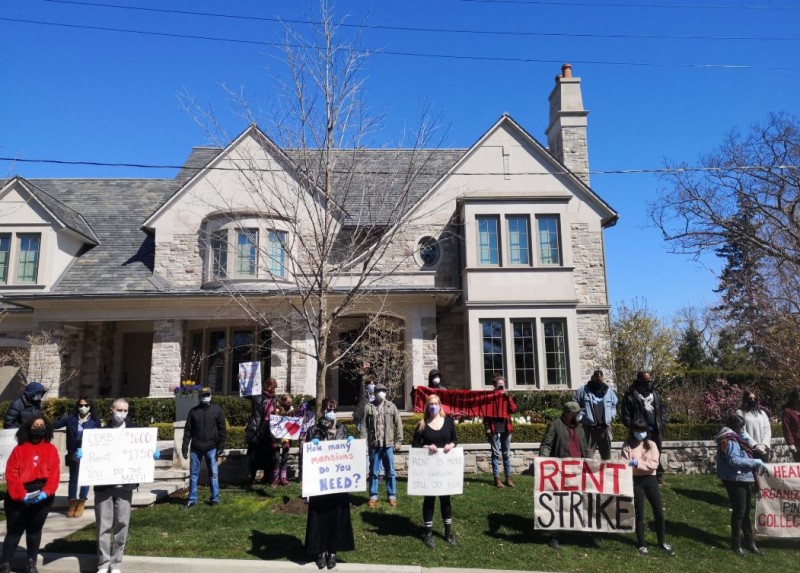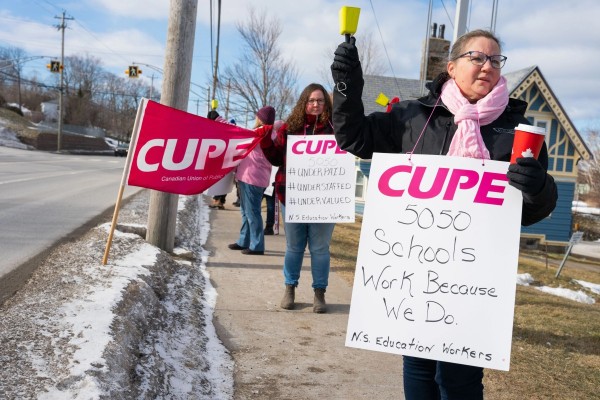Online activism during COVID-19: A case study in rent strikes

Tenants from Mississauga, Scarborough, and Parkdale visited the mansions of their landlords George Grossman (CEO, Pinedale Properties) and Daniel Drimmer (CEO, Starlight) to demand no evictions and rent forgiveness for those unable to pay rent during COVID-19. Photo by Keep Your Rent Toronto/Twitter.
Grève, Grève, Grève!
In the days leading up to April 1 in Montreal, white bed sheets billowed from windows across the city. Some were blank, while others called for (gréves des loyers*, or a rent strike, in painted lettering. With or without words, the message was clear: keep your rent this month. I will, we will, and you should too.
On Twitter, the #KeepYourRent hashtag collects similar images; photos of Keep Your Rent posters plastered around Toronto have been shared widely. Users across the country are connecting others to resources, leveraging momentum through retweets, likes and shares.
Since the first round of rent strikes swept through the country amidst the COVID-19 pandemic, Canadian tenants still face great uncertainty. While May brought federal rent relief for commercial tenants through the Canada Emergency Commercial Rent Assistance (CECRA) program, a program for non-commercial tenants has yet to be implemented. As June 1 approaches, numerous organizations and unions are calling for tenants to rent strike again.
More than three million Canadians are classified as working tenants and nearly half have less than a month of savings in their bank account, according to a report by the Canadian Centre for Policy Alternatives. An inability to pay rent isn’t just a Vancouver or Toronto problem; it’s a Canadian problem, and one that is affecting some of the most marginalized communities during this pandemic. At its worst, some tenants worry about the prospect of homelessness once provinces lift the temporary ban on evictions.
In Ontario, this fear has hit closer to home with the passing of Bill 184, ironically entitled the Protecting Tenants and Strengthening Community Housing Act. Contrary to its name, the Ontario NDP and members of Parkdale Organize have argued that the bill would make it easier for landlords to evict and prevent hearings from tenants on the occasion of missed payments.
Measures put in place to help flatten the curve have left many Canadian tenants out of work. In areas like Toronto and Vancouver, the Canada Emergency Response Benefit (CERB) may not be enough to cover rent and basic necessities. Further, according to a poll by ACORN Canada, 42 percent of the renters surveyed do not qualify for CERB or employment insurance (EI). Therefore, when nearly half of the Canadian tenants surveyed cannot rely on government funding for aid, it becomes a question of just how long it will be until they fall through the cracks of an already unsustainable system.
Rent strikes occurring across Canada
As June 1 looms around the corner, two months of tenant action on a local and national scale has already made its mark. Leading up to the first round of COVID-19 rent strikes on April 1, tenants at 87 Jameson Avenue in Parkdale told their landlord, MetCap, that they would “not be paying rent until it is deemed safe for [them] to return to work”. Around the same time, the organizers behind Keep Your Rent Toronto have stated that over 100,000 letters were sent to landlords through their platform stating that tenants would be going on a rent strike. Most recently, tenants from across the Greater Toronto Area (GTA) organized on the lawns of their landlords’ mansions to demand rent forgiveness and no evictions during the pandemic.
The energy behind these strikes is not only fuelled by single tenants, they also function as an act of solidarity for neighbours and others in their region who cannot pay rent. As Dave Diewert of Stop Evictions Burnaby told CityNews Burnaby, “It shields people who aren’t able to pay rent for all kinds of reasons from being particularly targeted by landlords for harassment or aggression”, even if those who cannot pay are in the minority.
Historically, rent strikes have resulted in successful outcomes and forced governments to amend issues faced by tenants, from rent control in the early twentieth century to battling the consequences of gentrification. In regions with a history of rent strikes and highly-organized bodies like in Parkdale, the basis to strike is more feasible than in regions where attempts have never been made or organized. Regions with established tenant unions, such as Vancouver and Halifax have more of a safety net, too. However, previous rent strikes, like those that have taken place in Parkdale, offer a framework for success. Above all, we must remember that rent strikes and the underlying issues that fuel them did not begin with COVID-19; the pandemic merely highlighted the symptoms of deep-seated and systemic inequalities facing tenants across the country.
Courage Coalition’s cross-Canada rent strike map.
The digital shift
Social distancing measures have forced virtually all methods of organization online. Organizing bodies have therefore been driven to find new and creative ways to mobilize collective action. Digital activism has existed for decades—but what happens when it becomes the only method to lean on?
The Courage Coalition, an independent Canadian left organization has stepped up to act as a starting point for Canadians looking to rent strike. On their Cancel Rent campaign webpage, showing solidarity is as simple as filling out your phone number, postal code, and choosing if, and under what circumstances you will strike. Local organizers can also submit on behalf of a block, and at the same time, be connected to other regional organizers. Databases like this can quantify strike potential and support—and in a time of great uncertainty, reassurance can be a relief.
Social media platforms, too, have acted as a means of garnering support and spreading resources. The Twitter account @KeepYourRentToronto took the initiative to outline five steps for tenants to organize rent strikes in their buildings, suggesting posters and group chats to fuel letters and demands to be sent to landlords. From legal resources to insider news from local tenants themselves, community organizations and social media activists, however formal or informal, have been the backbone of rent strikes in these turbulent weeks and months.
What are the limits?
The success of a rent strike depends much more on solidarity between neighbours than national support. If tenants are unable to make their rent, the consensus most provincial governments have come to suggests that tenants and landlords should negotiate towards a middle-ground solution. Yet with actions like the passing of Bill 184 by the Ontario government, the so-called “solutions” blatantly work in the favour of landlords by making it easier for tenants to be denied hearings and face eviction. If not a strike, what other solutions have been proposed?
In the Toronto Star, housing economist Marion Steele argues that the federal government must provide a “top-up” to renters living in areas where the CERB is not enough to cover both rent and basic necessities. For recent movers paying market rent in Toronto, the remainder of CERB is “barely enough for groceries, at under $280”. Steele also notes that this would prevent possible evictions after bans are lifted as deferred payments would not build overtime, merely pushing the issue into the future.
Ultimately, the solution is complex. For now, it may lie in either increased financial support for renters or the suspension of rent for the duration of the pandemic. Yet the issues faced nationally by tenants go beyond and predate the current crisis. As Bryan Doherty of Keep Your Rent Toronto said as an important reminder in NOW Toronto, “No one knows how things are going to unfold, but what we know is that we need to organize with each other. Hashtags and petitions are not going to pull us out of the fire.”
#KeepYourRent is not a ‘hashtag movement’ — it’s a call to organize with your neighbours to defend your collective interests as working class people.
— Keep Your Rent Toronto (@KeepYourRent) April 2, 2020
Because it works.
Potential for action amid COVID-19
A digital call for mobilization cannot act as a substitute for action. Rent strikes, in particular, rely largely on the support of other tenants in one’s province, city and apartment block to follow suit. This, however, is not the premise of what organizations like Parkdale Organize and the Courage Coalition are working tirelessly (and digitally) to achieve. Instead, their work serves as a bridge, connecting regional, national, and international movements to tenants and their neighbours. At the same time, it builds an argument, visible to tenants, non-tenants, and policymakers alike, that highlights the collective struggle of renters and the need for assistance in the face of COVID-19.
To have an entire movement spanning provincial borders despite a lack of physical connection is to have a national basis of solidarity demanding that tenants matter; that they deserve aid in the time of a global crisis, and that their interests will not be pushed aside in policy decisions—not during, or after an unprecedented global transformation.
Collective action does not stop in the face of spatial distancing. The presence—and success—of online calls to action during COVID-19 only prove this sentiment. And while online activism is nothing without action, it has undeniably fostered and strengthened collective solidarity among tenants across the country.
Moreover, this pandemic has highlighted the symptoms of an ongoing collective struggle among renters. Will the Canadian state tend to them, or leave them to worsen?
Cierra Bettens is entering her third year of studies pursuing an honours degree in political science at the University of Winnipeg. She writes about social change on Treaty 1 territory.










